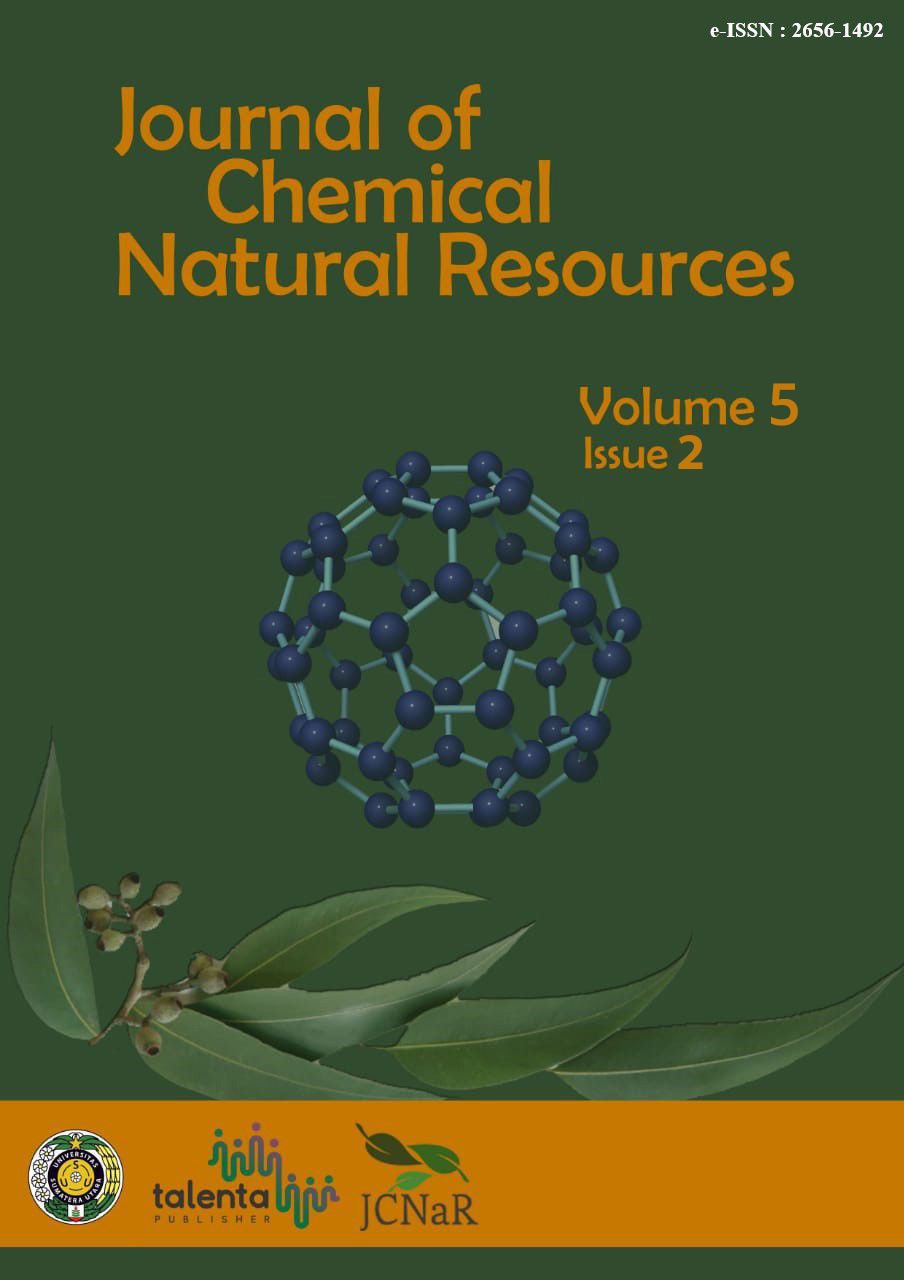Characterization of Bioplastics from Breadfruit (Artocarpus altilis) Starch and Carboxy Methyl Cellulose (CMC) with Glycerol Plasticizer
DOI:
https://doi.org/10.32734/jcnar.v5i2.14316Keywords:
Breadfruit Starch; Bioplastics; Carboxy Methyl Cellulose; GlycerolAbstract
Research on the synthesis of bioplastic from breadfruit (Artocarpus altilis) starch and carboxy methyl cellulose (CMC) has been successfully carried out with the addition of glycerol. Samples are conducted by varying the glycerol concentrations (10%, 20%, 30%, and 40%) at 60oC, respectively. The bioplastic product was tested using tensile strength, elongation, water content absorption, biodegradability, and Fourier transform-infra infrared (FT-IR). The tensile strength properties from bioplastic result evaluated is 34.26 N/mm2. The elongation at break of bioplastic is found at 21.4%. Water content results from bioplastic of 44%. Biodegradability study that bioplastics of 20% in 32 days. Correspondingly, the FT-IR confirmed the functional groups of bioplastics from breadfruit starch and CMC with glycerol.
Downloads
References
M. Borghei, A. Karbassi, S. Khoramnejadian, A. Oromiehie, and A. Hossein Javid, “Microbial biodegradable potato starch based low density polyethylene,†African J. Biotechnol., vol. 9, no. 26, pp. 4075–4080, 2010.
D. Ahmann and J. R. Dorgan, “Bioengineering for pollution prevention through development of biobased energy and materials state of the science report,†Ind. Biotechnol., vol. 3, no. 3, pp. 218–259, Oct. 2007, doi: 10.1089/ind.2007.3.218.
Y. Darni and H. Utami, “Studi Pembuatan Dan Karakteristik Sifat Mekanik dan Hidrofobisitas Bioplastik Dari Pati Sorgum,†J. Rekayasa Kim. dan Lingkung., vol. 7, no. 2, pp. 88–93, 2010.
Z. N. Diyana et al., “Physical properties of thermoplastic starch derived from natural resources and its blends: A review,†Polymers (Basel)., vol. 13, no. 9, pp. 5–20, 2021, doi: 10.3390/polym13091396.
I. Farida, K. Syamsu, and M. Rahayuningsih, “Direct bioethanol production from breadfruit starch (Artocarpus communis forst) by engineered simultaneous saccharification and fermentation (ESSF) using microbes consortium,†Int. J. Renew. Energy Dev., vol. 4, no. 1, pp. 25–31, 2015, doi: 10.14710/ijred.4.1.25-31.
M. M. Abe et al., “Advantages and disadvantages of bioplastics production from starch and lignocellulosic components,†Polymers (Basel)., vol. 13, no. 15, 2021, doi: 10.3390/polym13152484.
N. Kamal, “Pengaruh Bahan Aditif CMC (Carboxyl Methyl Cellulose) Terhadap Beberapa Parameter Pada Larutan Sukrosa,†J. Teknol., vol. 1, no. 7, pp. 78–84, 2014.
S. Elean, C. Saleh, and N. Hindryawati, “Pembuatan Film Biodegradable dari Pati Biji Cempedak dan Carboxy Methyl Cellulose dengan Penambahan Gliserol,†J. At., vol. 3, no. 2, pp. 122–126, 2018.
E. P. D. Putra and H. Saputra, “Karakterisasi Plastik Biodegradable Dari Pati Limbah Kulit Pisang Muli Dengan Plasticizer Gliserol,†J. Teknol. Pertan. Andalas, vol. 24, no. 1, 2020.
M. K. Hidayat, Latifah, and S. M. R. Sedyawati, “Penggunaan Carboxy Methyl Cellulose Dan Gliserol Pada Pembuatan Plastik Biodegradable Pati Gembili,†Indones. J. Chem. Sci., vol. 2, no. 3, pp. 253–258, 2013.
I. G. Sanjaya and T. Puspita, “Pengaruh Penambahan Kitosan dan Plasticizer Gliserol Pada Karakteristik Plastik Biodegradable Dari Pati Limbah Kulit Singkong,†J. Tek. Kim. FTI-ITS, 2009.
T. Bourtoom, “Review article edible films and coatings: characteristics and properties,†J. Int. Food Res., vol. 15, no. 3, pp. 237–248, 2008.
I. A. Warzukni, “Pembuatan Dan Karakterisasi Plastik Biodegradable Pati Porang Dan Kitosan Dengan Plasticizer Gliserol. Skripsi.,†Universitas Sumatera Utara, 2020.
K. Selpiana., Riansya, J. F dan Yordan, “Pembuatan Plastik Biodegradable Dari Tepung Nasi Aking,†Palembang, 2015.
M. Kristiani, “Pengaruh Penambahan Kitosan dan Plasticizer Sorbitol Terhadap Sifat Fisiko-Kimia Bioplastik dari Pati Biji Durian (Durio zibethinus),â€Universitas Sumatera Utara, 2015.
F. Anggarini, “Aplikasi Plasticizer Gliserol Pada Pembuatan Plastik Biodegradable dari Biji Nangka. Skripsi.,†Universitas Negeri Semarang, 2013.
M. Fingerman, Bioremediation of Aquatic and Terrestrial Ecosystems. New Orleans: Science Publishers, Inc., NH, USA, 2005.
T. Sumarsono, “Biodegradasi Campuran Benzen, Toluen, dan Xilen (Btx) dalam Adsorben Clay oleh Konsorsium Mikroba dengan Penambahan Biosurfaktan Pseudomonas Putida T1(8),†Universitas Airlangga, 2011.
R. Ardiansyah, “Pemanfaatan Pati Umbi Garut untuk Pembuatan Plastik Biodegradable,†Universitas Indonesia, 2011.
L. Nurdini, D. Holipah, and R. M. Maulidina, “The Influence of Glycerol as Plasticizer in Physical Properties of Bioplastic from Bread Fruit Starch,†in Seminar Nasional Teknik Kimia “Kejuangan†: K07-1 - K07-6, Yogyakarta, 2017.
C. F. Zuhra, M. Ginting, and D. S. Siregar, “Synthesis of Cross-linked Breadfruit Starch (Artocarpus communis) using Epichlorohydrin,†no. Icocsti 2019, pp. 218–222, 2020, doi: 10.5220/0008878902180222.
K. Wilpiszewska, A. K. Antosik, B. Schmidt, J. Janik, and J. Rokicka, “Hydrophilic films based on carboxymethylated derivatives of starch and cellulose,†Polymers (Basel)., vol. 12, no. 11, pp. 1–16, 2020, doi: 10.3390/polym12112447.

Downloads
Published
Issue
Section
License
Copyright (c) 2024 Journal of Chemical Natural Resources

This work is licensed under a Creative Commons Attribution-ShareAlike 4.0 International License.














